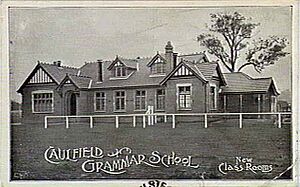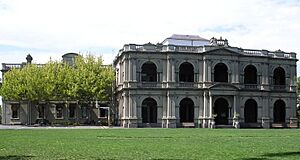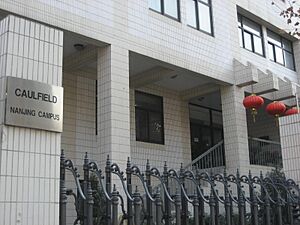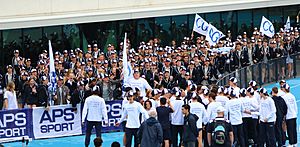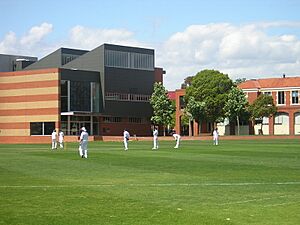Caulfield Grammar School facts for kids
Quick facts for kids Caulfield Grammar School |
|
|---|---|
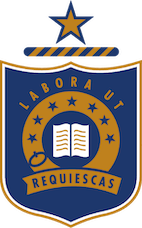 |
|
| Location | |
|
Melbourne, Victoria (main campuses)
Australia
|
|
| Coordinates | 37°52′34″S 145°0′11″E / 37.87611°S 145.00306°E |
| Information | |
| Type | Private school, co-educational, day and boarding, Christian school |
| Motto | Latin: Labora Ut Requiescas (Work hard that you may rest content) |
| Denomination | Anglican |
| Established | 25 April 1881 |
| Founder | Joseph Henry Davies |
| Principal | Ashleigh Martin |
| Employees | 800+ |
| Gender | Co-educational |
| Enrolment | 3,470 (K–12) |
| Colour(s) | Blue & White |
| Slogan | Mind for life. |
| Song | The School Song |
| Publication | Labora |
| Yearbook | The Grammarian |
| Annual tuition | $20,000 – $36,000 + $30,000 for boarding students |
| Affiliation | Associated Public Schools of Victoria |
| Alumni | Caulfield Grammarians |
Caulfield Grammar School is a private school in Melbourne, Australia. It welcomes both boys and girls, making it a co-educational school. It is also an Anglican school, meaning it has ties to the Christian church. Students can attend as day students or live at the school as boarding students.
The school started in 1881 as a school just for boys. One hundred years later, in 1981, girls began to join the school. In 1961, Caulfield Grammar joined with Malvern Memorial Grammar School. That school's campus then became the Malvern Campus of Caulfield Grammar.
Caulfield Grammar has three main campuses in Victoria for day students. These are in Caulfield (for Years 7–12), Wheelers Hill (for Kindergarten–Year 12), and Malvern House (for Kindergarten–Year 6). The school also has an outdoor education campus at Yarra Junction. Plus, there is a special student centre in Nanjing, China. This is where Year 9 students go for an international learning program. Caulfield Grammar is one of the largest schools in Victoria, with over 3,300 students.
Contents
Discovering Caulfield Grammar's Past
How Caulfield Grammar Started
Caulfield Grammar School was founded by Joseph Henry Davies. He had worked as a missionary in India. On April 16, 1881, he bought a small building that used to be a lolly shop. It was located near the Elsternwick railway station. Davies wanted the school to be a "thoroughly Christian one." He hired his sister and two brothers to teach there.
Even though the school was in Elsternwick, it was named Caulfield Grammar School. This was because Caulfield was the main area nearby. Also, the local church leader in Caulfield helped Davies open the school.
Caulfield Grammar School officially opened on April 25, 1881, with only nine students. Davies had planned to open earlier, but he changed the date at the last minute.
After one year, the school had 32 students. To fit more students, the school moved to a bigger building nearby. This building was later destroyed in a fire in 1890. In 1896, another small Christian school, Hawksburn Grammar School, joined Caulfield Grammar. Hawksburn's headmaster, Walter Murray Buntine, became the headmaster at Caulfield Grammar. All 55 students from Hawksburn moved to Caulfield Grammar.
The school bought its current main site in 1909. This property is near the Rippon Lea Estate in St Kilda East. Classes started there on February 9, 1909. The school's boarding house, where students could live, opened in 1912.
By 1931, the school's 50th anniversary, there were 500 students. To celebrate, they held a Jubilee Fair. In the same year, the school changed from being privately owned to being run by a School Council. This is how the school is still organized today. It also officially became part of the Church of England.
After World War II
In 1948, the school was renamed Malvern Memorial Grammar School. This was to honor former students who fought in World War I and World War II. In 1971, Malvern Memorial Grammar School joined with Shaw House. It then became the Malvern Campus, which is a primary school. Students there started wearing the Caulfield Grammar School uniform.
In 1958, Caulfield Grammar joined the Associated Public Schools of Victoria (APS) sports competition. By 1959, Caulfield Grammar was Victoria's fifth largest school, with over 800 students. In 1961, Caulfield Grammar School officially joined with Malvern Memorial Grammar School. Malvern Grammar School had opened in 1890 as a boys' secondary school. In 1924, it moved into Valentine's Mansion. This mansion was built in 1892 and has a large ballroom. Valentine's Mansion is now a protected historical building.
During the 1960s and 1970s, students started to speak up more. In 1970, elected student committees replaced appointed prefects. Students were allowed to publish a newsletter called Demos. This newsletter included articles about the school. Also, religious education classes became optional for older students. Caulfield Grammar was the only APS school that allowed its students to join protests against the Vietnam War in 1970.
In 1981, the school's 100th year, girls first joined Caulfield Grammar. A second senior school campus opened at Wheelers Hill on April 26. Caulfield Grammar had bought the land for this campus in 1969. The Wheelers Hill campus started as a co-educational school for all year levels. By 1993, all other campuses also welcomed girls, making Caulfield Grammar fully co-educational.
In 1997, the school set up a computer network. All students and staff got their own login details, email accounts, and file space. This is like a "virtual" campus. It lets students access their emails and files from anywhere with internet.
The school's historic War Memorial Hall was opened in 1958. It cost a lot of money to build. In November 2000, a big fire broke out in the building. It was being renovated and was almost finished. The roof collapsed, and the whole building was destroyed. Only the stained glass windows were saved.
After the fire, the school planned to build new halls at both the Caulfield Grammar and Wheelers Hill campuses. This project was called "The Twin Halls." The Memorial Hall at Wheelers Hill opened on July 28, 2005. The "Cripps Centre" at the Caulfield Grammar Campus opened on October 25, 2005. Each hall can seat 650 people. The Wheelers Hill hall has a new chapel. The Caulfield Grammar hall has a music and visual art department. Today, Caulfield Grammar School has over 3,000 students across its three day campuses.
The school is part of many important groups. These include the Associated Public Schools of Victoria (APS) and the Association of Heads of Independent Schools of Australia (AHISA).
Yarra Junction Campus
In 1947, an outdoor education center opened at Yarra Junction. The Cuming family donated the land. Cuming House was the first outdoor education campus for an Australian school. It is in the Australian bush, close to the Yarra River.
Today, students at the Yarra Junction Campus live in eco-cabins. These cabins use rainwater tanks and solar power. The Earth Studies Centre, called Wadambawilam, runs on wind and solar power. It teaches students about protecting the environment for the future. There is also a dairy farm on campus that produces a lot of milk each year. In 2001, the Yarra Junction Campus won an award for its energy-saving eco-cabins.
Nanjing Campus in China
In 1998, the school opened a fifth campus in Nanjing, China. This campus was built on land owned by the High School Affiliated to Nanjing Normal University. It was the first overseas campus for an Australian high school. It was also the first campus set up by a foreign secondary school in China.
Six Australian teachers work there full-time. Six Year 12 graduates also spend a year there as trainees. Most Caulfield Grammar Year 9 students go to Nanjing for a five-week international program. The Nanjing campus is currently closed temporarily.
Caulfield Grammar focuses on Mandarin Chinese as its main foreign language. The school started teaching Mandarin in 1963. It became the only Asian language taught because more students chose it. Mandarin has been taught at all year levels across all three campuses since 1994. Having a campus in Nanjing helped the school connect more with China. Nanjing was chosen because Jiangsu province, where Nanjing is located, is a sister-state to Victoria. Also, Nanjing University had already started an Australian studies department.
Stephen Newton, who was the principal of Caulfield Grammar from 1993 to 2011, received an award in 2012. He was honored for his great work in education. This included his role in starting the Nanjing Campus.
School Leaders
Caulfield Grammar School has had 10 headmasters and principals since it began. The current principal is Ashleigh Martin. He was appointed in 2018.
| Years | Name |
|---|---|
| 1881–1888 | Rev. J.H Davies |
| 1888–1896 | Rev. E.J. Barnett |
| 1896–1931 | Mr. W.M. Buntine |
| 1923–1954 | Mr. F.H.J. Archer |
| 1955–1964 | Rev. S.W. Kurrle |
| 1965–1977 | Mr. B.C. Lumsden |
| 1977–1992 | Rev. A.S. Holmes |
| 1993–2011 | Mr. S.H. Newton |
| 2011–2018 | Rev. A.P. Syme |
| 2018–present | Mr. A.R. Martin |
Learning and Activities
Academic Programs
Caulfield Grammar School offers many subjects. In middle school, all students study a language. They can choose Mandarin Chinese, French, or German. Students can continue these languages in later years if they wish. The school also offers scholarships. These are special awards for students who are excellent in academics, theater, music, art, or sports.
Outdoor Education Adventures
The Yarra Junction campus hosts student camps for different year levels. Year 3 students visit for one day. Year 5 students stay for three days. Year 7 students have one-week camps. Year 8 students have 11-day programs, which include a three-day outdoor camping trip. Older students from Years 10 and 11 can be student leaders on these camps. They attend a leadership camp first to prepare. During camps, students stay in eco-cabins and learn to save water and electricity. Lessons also take place at Wadambawilam and the campus dairy farm.
Student Life
Sports and Teams
Students from Years 5 to 12 take part in school sports. They compete in the APS competition. Caulfield Grammar was one of the first schools to join the Schools' Association of Victoria in 1882. Later, in 1958, Caulfield Grammar joined the Associated Public Schools of Victoria.
After joining the APS, the school made sports participation compulsory to improve its performance. Caulfield Grammar holds an APS record for winning 12 straight APS Boys' Athletics Championships from 1994 to 2005. They have also won many other championships. The First XVIII football team won 18 championships in a row from 1913 to 1930. This is the longest winning streak for a Caulfield Grammar Firsts team.
The main sports facilities are at both the Caulfield and Wheelers Hill campuses. At Caulfield Grammar, the Lindsay Thompson Centre is used for indoor sports like basketball and netball. The Alfred Mills Oval is where the First XI cricket and First XVIII football teams usually play.
Basketball Team Achievements
Championship Men (Open)
- Australian Schools Championships
The Arts and Debating
Caulfield Grammar has a senior orchestral group called the Galamian Orchestra. This group mainly plays string instruments. In 2005, famous jazz musician James Morrison performed with the school's "No Strings Attached" stage band. In 2006, this stage band and the senior concert band toured Europe. They even performed at the Montreux Jazz Festival.
Caulfield Grammar also competes in the Debaters Association of Victoria Schools competition. The Caulfield Campus hosts the regional competition. Students debate against other Melbourne schools on different current topics. Students also take part in mooting. This is where teams argue legal cases based on facts. They compete in the Bond University Mooting competition.
Former Students
All past students of the school are part of the Caulfield Grammarians' Association (CGA). This group organizes reunions, sports teams, and other activities for former students. The CGA started in 1885. The Caulfield Grammarians Football Club plays in the Victorian Amateur Football Association. Famous former Australian rules football players like Dean Anderson and Duncan Kellaway have played for this club.
Many former Caulfield Grammar students have achieved great things. They have made important contributions in government, sports, music, business, and other areas. For example, Peter Dowding and Lindsay Thompson both became state premiers in Australia. Swimmer Mack Horton has won many medals at the Olympic Games and World Championships. He won a gold medal in the 400m freestyle at the 2016 Summer Olympics.
Chris Judd and John Schultz both won the Brownlow Medal. This award is for the best player in the Victorian/Australian Football League. John Landy held the world record for the men's mile run and also served as Governor of Victoria. John Clifford Valentine Behan was the first Victorian to win a Rhodes Scholarship. Fred Walker founded the company that created Vegemite, a famous Australian spread.
The rock group The Birthday Party was formed by Nick Cave, Mick Harvey, and Phill Calvert. They were students at the school in 1973. Cave and Harvey later formed another band called Nick Cave and the Bad Seeds. This band released popular albums in Australia and the United Kingdom. Cave and Harvey were part of the school choir. Their choirmaster, Norman Kaye, later became a well-known actor and musician.
See also
- List of schools in Victoria, Australia
- Caulfield Grammarians Football Club


